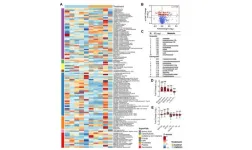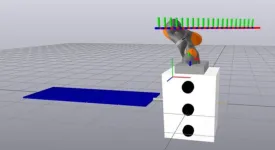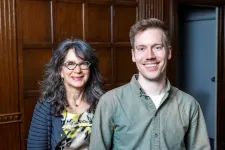(Press-News.org) Just as in Brazil drivers can be warned of traffic congestion ahead or a vehicle parked on the hard shoulder, notifications may soon pop up on their smartphone or on their car’s computer screen to warn them in real time that an anteater, wolf or tapir is crossing the highway. No human will necessarily need to see the animal in question or press a control button to send the warning.
For this to be possible, a key step is construction of a computer vision model that automatically detects Brazilian wild animals. Researchers supported by FAPESP have done this, as described in an article published in the journal Scientific Reports.
“The species were selected in accordance with the metrics recommended by the Brazilian Center for Road Ecology Studies [CBEE, at the Federal University of Lavras, UFLA]. According to this center’s estimates, some 475 million animals are killed on Brazilian roads every year. We created a database of Brazilian species and trained a number of computer vision models to detect them,” said Gabriel Souto Ferrante, first author of the article. He conducted the study as part of his master’s research at the University of São Paulo’s Institute of Mathematics and Computer Sciences (ICMC-USP) in São Carlos.
According to Rodolfo Ipolito Meneguette, a professor at ICMC-USP, Ferrante’s supervisor and last author of the article, groups in other countries have been working for some time on systems that detect wild animals with the use of artificial intelligence, but models built abroad are not good at detecting Brazilian animals. Moreover, few are designed to identify animals on roads, an application that requires fast detection in environments where visibility may often be poor.
“Drivers also run a significant risk in collisions with large animals. They often have insufficient time to take action to avoid them. Our system uses roadside cameras coupled to a portable computer and is innovative in that respect,” he said.
The study was part of two projects also supported by FAPESP: “Services for an intelligent transport system”; and “Dynamic resource management for intelligent transportation system applications”.
Instant detection
To develop a system that recognizes Brazilian species, the researchers first built a database of Brazilian mammals that are most likely to be hit by road traffic, locating and downloading from the internet 1,823 photographs in the public domain (without copyright protection). Where necessary, the images were edited to remove “noise” (random variations in color, brightness, etc.) that could hinder identification of the species, or to assist identification by including a diversity of angles.
The researchers then tested different versions of YOLO (You Only Look Once), a computer vision algorithm widely used for real-time detection of objects, including wild animals. One of its advantages is single-stage detection, the most suitable type for real-time identification of large animals, as speed is favored over accuracy. Another factor that influenced the choice was the possibility of running the system on so-called edge devices, such as tablets and portable computers with relatively limited resources.
Videos of animals recorded by the researchers in São Carlos Ecological Park were used to test the efficiency of the system. Future updates to the database will include images of animals captured by forest camera traps and roadside cameras.
Curiously, older versions of YOLO were better at detecting animals. “The models correctly detected the species in 80% of images taken during the day with the animal appearing clearly,” Ferrante said. Typical computer vision problems (such as poor detection at night, in wet weather or when the animal is partially hidden) persist and will be the focus of future studies.
New images will be included in the database, and partnerships with toll road operators and city governments will enable the system to be tested in real-world situations, including integration with existing technologies.
In 2020, the group led by Meneguette developed an application that informs drivers about traffic conditions using real-time data collected by road users’ smartphones in Catanduva, a city in São Paulo state. The difference from apps like Waze or Google Maps is that in this system the municipal traffic authorities can input data.
“One possibility would be to couple our animal detection system to this app, which we already have, and thereby enhance animal and driver safety,” Meneguette said.
About São Paulo Research Foundation (FAPESP)
The São Paulo Research Foundation (FAPESP) is a public institution with the mission of supporting scientific research in all fields of knowledge by awarding scholarships, fellowships and grants to investigators linked with higher education and research institutions in the State of São Paulo, Brazil. FAPESP is aware that the very best research can only be done by working with the best researchers internationally. Therefore, it has established partnerships with funding agencies, higher education, private companies, and research organizations in other countries known for the quality of their research and has been encouraging scientists funded by its grants to further develop their international collaboration. You can learn more about FAPESP at www.fapesp.br/en and visit FAPESP news agency at www.agencia.fapesp.br/en to keep updated with the latest scientific breakthroughs FAPESP helps achieve through its many programs, awards and research centers. You may also subscribe to FAPESP news agency at http://agencia.fapesp.br/subscribe.
END
System uses artificial intelligence to detect wild animals on roads and avoid accidents
The researchers trained computer vision models to identify Brazilian mammals must susceptible to roadkill in real time and are partnering with toll road operators to test the system in real-world situations.
2024-04-09
ELSE PRESS RELEASES FROM THIS DATE:
Has remote work changed how people travel in the U.S?
2024-04-09
The prevalence of remote work since the start of the Covid-19 pandemic has significantly changed urban transportation patterns in the U.S., according to new study led by MIT researchers.
The research finds significant variation between the effects of remote work on vehicle miles driven and on mass-transit ridership across the U.S.
“A 1 percent decrease in onsite workers leads to a roughly 1 percent reduction in [automobile] vehicle miles driven, but a 2.3 percent reduction in mass transit ridership,” says Yunhan Zheng SM ’21, PhD ’24, an MIT postdoc who is co-author of the study.
“This is one of the first studies that identifies the causal effect ...
UC Irvine scientist helps link climate change to Madagascar’s megadrought
2024-04-09
Irvine, Calif., April 9, 2024 — A University of California, Irvine-led team reveals a clear link between human-driven climate change and the years-long drought currently gripping southern Madagascar. Their study appears in the Nature journal Climate and Atmospheric Science.
“Using remotely sensed observations and climate models, we could see evidence that climate change is affecting the hydrological cycle in southern Madagascar, and it’s likely going to have big implications for the people that live there and how they grow their food,” ...
CMS121 mitigates aging-related obesity and metabolic dysfunction
2024-04-09
“[...] CMS121 applicability could be expanded from a geroneuroprotector drug to a metabolic drug [...]”
BUFFALO, NY- April 9, 2024 – A new research paper was published in Aging (listed by MEDLINE/PubMed as "Aging (Albany NY)" and "Aging-US" by Web of Science) Volume 16, Issue 6, entitled, “CMS121: a novel approach to mitigate aging-related obesity and metabolic dysfunction.”
Modulated by differences in genetic and environmental factors, laboratory mice often show progressive weight gain, eventually leading to obesity and metabolic dyshomeostasis. ...
AACR: How cellular plasticity drives cancer metastasis
2024-04-09
About 90% of deaths from cancer are a result of metastasis — that is, from cancer’s ability to spread from an initial primary tumor to seed new tumors throughout the body, often in the lungs, liver, and brain.
And metastasis relies on cancer cells’ ability to adapt to different tissue environments throughout the body by gaining improper access to a variety of playbooks stored in our genetic code — including gene programs that are generally available only during early stages of human development.
Today, researchers at Memorial Sloan Kettering Cancer Center (MSK) are using innovative approaches like single-cell sequencing technology ...
Free public education event on neuromodulation therapies to be held at Vancouver Convention Centre
2024-04-09
Vancouver, BC – The Canadian Neuromodulation Society and the International Neuromodulation Society (INS) are delighted to announce a public education event, "Understanding Neuromodulation of the Brain and Spinal Cord”.
This complimentary event is scheduled to take place at the Vancouver Convention Centre, East Building, on Saturday, May 11, from 13:30 to 18:00, during the 16th INS World Congress.
Aimed at patients, their families, and friends dealing with conditions such as chronic pain, Parkinson’s disease, and tremor, this event is ...
SwRI demonstrating robotics for in-space manufacturing at Space Symposium
2024-04-09
SAN ANTONIO — April 9, 2024 — Southwest Research Institute has invested in new space robotics capabilities to help the space industry pave the way for in-space servicing, assembly and manufacturing (ISAM) capabilities. SwRI’s Intelligent Systems Division will demonstrate new ISAM-focused research at the 38th Space Symposium, April 8-11, in Colorado Springs. Visit SwRI at Booth #237.
“SwRI is developing solutions to leverage Earth-based industrial robotics with advanced automation and simulation so we can help clients develop new capabilities for the complex conditions ...
Cleveland Clinic, Tufts University research ties gut microbial TMAO pathway to chronic kidney disease
2024-04-09
April 9, 2024, Cleveland: New findings from Cleveland Clinic and Tufts University researchers show high blood levels of TMAO (trimethylamine N-oxide) predicts future risk of developing chronic kidney disease over time.
The findings build on more than a decade of research spearheaded by Stanley Hazen, M.D., Ph.D., and a team related to the gut microbiome’s role in cardiovascular health and disease, including the adverse effects of TMAO, a byproduct formed by the gut bacteria from nutrients abundant in red meat, eggs and other animal source foods.
The study, published in the Journal of the American Society of Nephrology, was a collaboration ...
Ochsner Health utilizes groundbreaking ablation system for atrial fibrillation
2024-04-09
New Orleans, LA – Ochsner Health is proud to bring an advancement in the treatment of heart rhythm disorders to the New Orleans and Gulf South region utilizing a new cardiac ablation procedure, the FARAPULSE™ Pulsed Field Ablation System. The innovative procedure was performed at the John Ochsner Heart & Vascular Institute, a frontrunner in cardiology that continues to set the standard for cardiovascular care through its commitment to pioneering breakthrough therapies.
With the estimated number of individuals affected by atrial fibrillation predicted to rise to 12.1 million in the United States by 2030 according to the CDC, the introduction of this new treatment ...
Brigham researchers develop SCENT for genetic mapping of autoimmune diseases
2024-04-09
Genetic studies of diseases map segments of the genome driving disease. But to understand how those changes contribute to disease progression, it is important to understand how they may alter gene regulation of disease genes in cell populations assumed to be driving disease. “Enhancer-gene maps” link genomic regulatory regions to genes and are essential for understanding disease. But constructing them poses challenges due to limitations in current experimental methods, that make it difficult to apply the technique to rare cell populations and genes that ...
Cognitive decline may be detected using network analysis, according to Concordia researchers
2024-04-09
We all lose our car keys or our glasses from time to time. Most people would be correct to laugh it off as a normal part of aging. But for others, cognitive decline may start as a worrying but clinically unnoticeable step toward cognitive impairment, be it relatively mild or as severe as Alzheimer’s disease.
The vast complexity of the human brain makes early diagnosis of cognitive decline difficult to achieve, which has potentially important implications for treatment and prevention. This is especially true ...
LAST 30 PRESS RELEASES:
Numbers in our sights affect how we perceive space
SIMJ announces global collaborative book project in commemoration of its 75th anniversary
Air pollution exposure and birth weight
Obstructive sleep apnea risk and mental health conditions among older adults
How talking slows eye movements behind the wheel
The Ceramic Society of Japan’s Oxoate Ceramics Research Association launches new international book project
Heart-brain connection: international study reveals the role of the vagus nerve in keeping the heart young
Researchers identify Rb1 as a predictive biomarker for a new therapeutic strategy in some breast cancers
Survey reveals ethical gaps slowing AI adoption in pediatric surgery
Stimulant ADHD medications work differently than thought
AI overestimates how smart people are, according to HSE economists
HSE researchers create genome-wide map of quadruplexes
Scientists boost cell "powerhouses" to burn more calories
Automatic label checking: The missing step in making reliable medical AI
Low daily alcohol intake linked to 50% heightened mouth cancer risk in India
American Meteorological Society announces Rick Spinrad as 2026 President-Elect
Biomass-based carbon capture spotlighted in newly released global climate webinar recording
Illuminating invisible nano pollutants: advanced bioimaging tracks the full journey of emerging nanoscale contaminants in living systems
How does age affect recovery from spinal cord injury?
Novel AI tool offers prognosis for patients with head and neck cancer
Fathers’ microplastic exposure tied to their children’s metabolic problems
Research validates laboratory model for studying high-grade serous ovarian cancer
SIR 2026 delivers transformative breakthroughs in minimally invasive medicine to improve patient care
Stem Cell Reports most downloaded papers of 2025 highlight the breadth and impact of stem cell research
Oxford-led study estimates NHS spends around 3% of its primary and secondary care budget on the health impacts of heat and cold in England
A researcher’s long quest leads to a smart composite breakthrough
Urban wild bees act as “microbial sensors” of city health.
New study finds where you live affects recovery after a hip fracture
Forecasting the impact of fully automated vehicle adoption on US road traffic injuries
Alcohol-related hospitalizations from 2016 to 2022
[Press-News.org] System uses artificial intelligence to detect wild animals on roads and avoid accidentsThe researchers trained computer vision models to identify Brazilian mammals must susceptible to roadkill in real time and are partnering with toll road operators to test the system in real-world situations.




